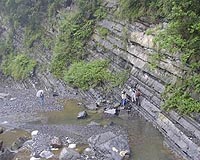| . |  |
. |
Paris (AFP) July 29, 2009 Biomedical researchers on Wednesday said they could explain why we swing our arms when we walk, a practice that has long piqued scientific curiosity. Swinging one's arms comes at a cost. We need muscles to do it, and we need to provide energy in the form of food for those muscles. So what's the advantage? Little or none, some experts have said, contending that arm-swinging, like our appendix, is an evolutionary relic from when we used to go about on all fours. But a trio of specialists from the United States and the Netherlands have put the question to rigorous tests. They built a mechanical model to get an idea of the dynamics of arm-swinging and then recruited 10 volunteers, who were asked to walk with a normal swing, an opposite-to-normal swing, with their arms folded or held by their sides. The metabolic cost of this activity was derived from oxygen consumption and carbon dioxide (CO2) production as the human guinea pigs breathed in and out. Arm-swinging turned out to be a plus, rather than a negative, the investigators found. For one thing, it is surprisingly, er, "'armless" in energy costs, requiring little torque, or rotational twist, from the shoulder muscles. Holding one's arms as one walks requires 12 percent more metabolic energy, compared with swinging them. The arms' pendulum swing also helps dampen the bobbly up-and-down motion of walking, which is itself an energy drain for the muscles of the lower legs. If you hold your arms while walking, this movement, called vertical ground reaction moment, rises by a whopping 63 percent. Should you prefer to walk with an opposite-to-normal swing -- meaning that your right arm moves in sync with your right leg and your left arm is matched to the motion of your left leg -- the energy cost of using your shoulder muscles will fall. The downside, though, is that opposite-to-normal swing forces up the metabolic rate by a quarter. The study, headed by Steven Collins at the University of Michigan at Ann Arbor, says we should give the thumb's-up to arm swinging. "Rather than a facultative relic of the locomotion needs of our quadrupedal ancestors, arm swinging is an integral part of the energy economy of human gait," says the paper. It appears in Proceedings of the Royal Society B, the biological research journal of the Royal Society, Britain's de-facto academy of sciences. Share This Article With Planet Earth
Related Links Darwin Today At TerraDaily.com
 Earliest Animals Lived In A Lake Environment
Earliest Animals Lived In A Lake EnvironmentRiverside CA (SPX) Jul 29, 2009 Evidence for life on Earth stretches back billions of years, with simple single-celled organisms like bacteria dominating the record. When multi-celled animal life appeared on the planet after 3 billion years of single cell organisms, animals diversified rapidly. Conventional wisdom has it that animal evolution began in the ocean, with animal life adapting much later in Earth history to ... read more |
|
| The content herein, unless otherwise known to be public domain, are Copyright 1995-2009 - SpaceDaily. AFP and UPI Wire Stories are copyright Agence France-Presse and United Press International. ESA Portal Reports are copyright European Space Agency. All NASA sourced material is public domain. Additional copyrights may apply in whole or part to other bona fide parties. Advertising does not imply endorsement,agreement or approval of any opinions, statements or information provided by SpaceDaily on any Web page published or hosted by SpaceDaily. Privacy Statement |